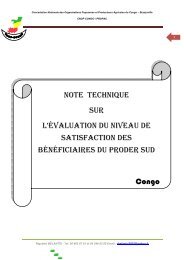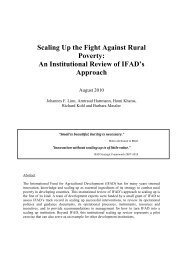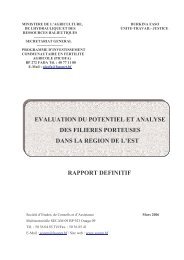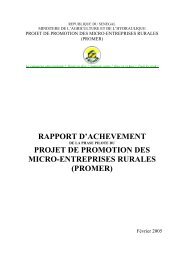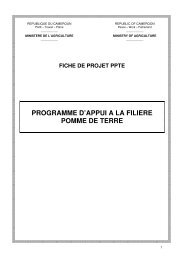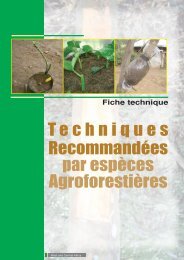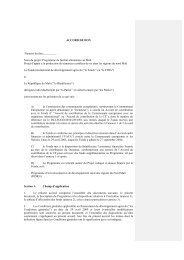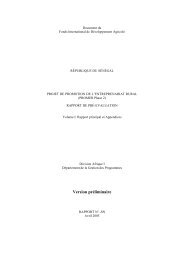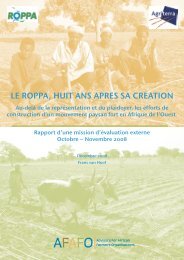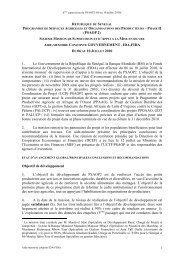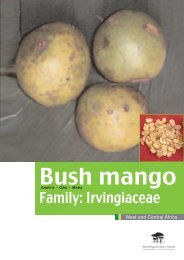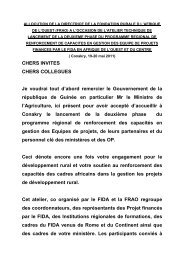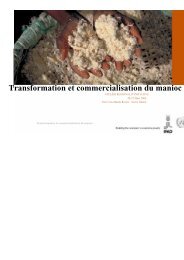CASSAVA OPPORTUNTIES IN NIGERIA - FAO.org
CASSAVA OPPORTUNTIES IN NIGERIA - FAO.org
CASSAVA OPPORTUNTIES IN NIGERIA - FAO.org
Create successful ePaper yourself
Turn your PDF publications into a flip-book with our unique Google optimized e-Paper software.
1 <strong>IN</strong>TRODUCTION<br />
In the early years of Nigeria’s independence,<br />
agriculture accounted for nearly 60 percent of<br />
Gross Domestic Product (GDP) and 80 percent of<br />
export earnings (Shaib, Aliyu, and Bakshi, 1997).<br />
Today agriculture accounts for a third of GDP and<br />
less than one percent of export earnings, oil<br />
accounting for the rest 1 .<br />
Although room exists for Nigeria to prosper, the<br />
country continues to face a number of challenges.<br />
Policies to date have yet to diversify the<br />
productive base away from the continued reliance<br />
on a single industry, petroleum. There continues<br />
to be underutilization of industrial capacity, high<br />
unemployment and political anxiety.<br />
A desirable outcome for the Nigerian populous<br />
and current government is a strong diversified<br />
economy able to generate employment and<br />
sustain incomes for its citizens. Increasing the<br />
productivity of agriculture, increasing the<br />
utilization of industrial capacity, diversifying export<br />
earnings and providing gainful employment for its<br />
population are all desirable targets.<br />
To achieve this, President Olusegun Obasanjo’s<br />
newly elected government, in 1999, pledged to<br />
support the agricultural sector and announced the<br />
need for immediate action in five agricultural<br />
subsectors: cassava, rice, vegetable oils, livestock<br />
and tree crops. The cassava initiative alone seeks<br />
to generate US$5 billion in export revenue by<br />
2007. Since its launch in July 2002, great<br />
excitement has been generated, creating new<br />
hopes and even greater expectations.<br />
To compliment this Initiative, IITA together with<br />
the Nigerian National Petroleum Corporation<br />
(NNPC) recently signed a four year action plan<br />
providing local communities with cassava mosaic<br />
disease resistant planting materials and<br />
production and marketing support. These<br />
improved cultivars also produce more cassava per<br />
plant. Their distribution to farmers could lead to a<br />
1 Oil represents 99.6 percent of total exports, valued at 1 979<br />
337 million N or US$17 418 million in 2001. There are 12<br />
pages of exports classified by commodity and country in the<br />
2001 Nigeria Foreign Trade Summary compared to 564 pages<br />
of imports (Federal Office of Statistics, 2001).<br />
1<br />
substantial increase in production (IITA, 2003).<br />
The question is can the utilization of cassava grow<br />
sufficiently to mirror farmer’s enhanced ability to<br />
produce cassava?<br />
1.1 STUDY OBJECTIVES<br />
The primary objective of this study was to<br />
determine the actual and potential size of the<br />
market for cassava and cassava based products<br />
in Nigeria and what is required in terms of<br />
economic, social and physical investments to<br />
develop an efficient cassava industrial sector. The<br />
specific objectives and activities directing this<br />
study are provided in Appendix A.<br />
The intended audience for the report was to<br />
include large, medium and small-scale private<br />
sector investors, farmers and processors. It was<br />
also intended to guide donor and development<br />
bank investments and government policy.<br />
The study team comprised two agricultural<br />
economists, a local post harvest specialist and an<br />
agronomist. Work began in November 2003 with<br />
an extensive search for available data on the<br />
Nigerian cassava industry. This involved visits by<br />
team members to all state agricultural<br />
development programmes (ADPs), federal offices,<br />
and key industrial informants. Duplication was<br />
minimized by not visiting those informants and<br />
industries already visited by previous consultants.<br />
Instead information from their reports was used in<br />
this report.<br />
The task for this single report is enormous. It is<br />
obvious that in its current form, the information<br />
contained in this report may be too detailed to<br />
interest large, medium and small-scale investors,<br />
donors, governments and development banks.<br />
Condensed reports or pamphlets for industrial<br />
application should be gleamed from this report to<br />
suit specific end user interests. The data<br />
intensive nature of this study lead to a companion<br />
document being assembled, entitled “The<br />
Nigerian Cassava Industry: Statistical Handbook”.<br />
1.2 THE <strong>CASSAVA</strong> STATISTICAL HANDBOOK<br />
This study draws heavily from previously<br />
presented material on simulating the cassava<br />
industry in Nigeria. It was also the intention of this<br />
study to draw heavily on data collected and<br />
collated by the industry and State and Federal



